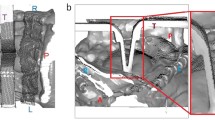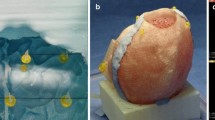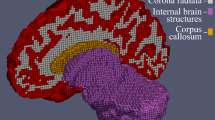Abstract
There are different stress–strain definitions to measure the mechanical properties of the brain tissue. However, there is no agreement as to which stress–strain definition should be employed to measure the mechanical properties of the brain tissue at both the longitudinal and circumferential directions. It is worth knowing that an optimize stress–strain definition of the brain tissue at different loading directions may have implications for neuronavigation and surgery simulation through haptic devices. This study is aimed to conduct a comparative study on different results are given by the various definitions of stress–strain and to recommend a specific definition when testing brain tissues. Prepared cylindrical samples are excised from the parietal lobes of rats’ brains and experimentally tested by applying load on both the longitudinal and circumferential directions. Three stress definitions (second Piola–Kichhoff stress, engineering stress, and true stress) and four strain definitions (Almansi–Hamel strain, Green-St. Venant strain, engineering strain, and true strain) are used to determine the elastic modulus, maximum stress and strain. The highest non-linear stress–strain relation is observed for the Almansi–Hamel strain definition and it may overestimate the elastic modulus at different stress definitions at both the longitudinal and circumferential directions. The Green-St. Venant strain definition fails to address the non-linear stress–strain relation using different definitions of stress and triggers an underestimation of the elastic modulus. The results suggest the application of the true stress–true strain definition for characterization of the brain tissues mechanics since it gives more accurate measurements of the tissue’s response using the instantaneous values.





Similar content being viewed by others
References
Nguyen SY, Dormieux L. A Burger model for the effective behavior of a microcracked viscoelastic solid. Int J Damage Mech. 2011;20:1116–29.
Miller K. Constitutive model of brain tissue suitable for finite element analysis of surgical procedures. J Biomech. 1999;32:531–7.
Joldes GR, Wittek A, Miller K. Computation of intra-operative brain shift using dynamic relaxation. Comput Methods Appl Mech Eng. 2009;198:3313–20.
Miller K. Most recent results in the biomechanics of the brain. J Biomech. 2005;38:965; author reply 7, 9.
Miller K, Chinzei K. Mechanical properties of brain tissue in tension. J Biomech. 2002;35:483–90.
Velardi F, Fraternali F, Angelillo M. Anisotropic constitutive equations and experimental tensile behavior of brain tissue. Biomech Model Mechanobiol. 2006;5:53–61.
Karimi A, Navidbakhsh M, Motevalli Haghi A, Faghihi S. Measurement of the uniaxial mechanical properties of rat brains infected by Plasmodium berghei ANKA. Proc Inst Mech Eng H. 2013;227:609–14.
Pervin F, Chen WW. Effect of inter-species, gender, and breeding on the mechanical behavior of brain tissue. Neuroimage. 2011;54(Suppl 1):S98–102.
Miller K. Method of testing very soft biological tissues in compression. J Biomech. 2005;38:153–8.
Khanafer K, Schlicht MS, Berguer R. How should we measure and report elasticity in aortic tissue? Eur J Vasc Endovasc Surg. 2013;45:332–9.
Kaster T, Sack I, Samani A. Measurement of the hyperelastic properties of ex vivo brain tissue slices. J Biomech. 2011;44:1158–63.
van Dommelen JA, van der Sande TP, Hrapko M, Peters GW. Mechanical properties of brain tissue by indentation: interregional variation. J Mech Behav Biomed Mater. 2010;3:158–66.
Rashid B, Destrade M, Gilchrist MD. Inhomogeneous deformation of brain tissue during tension tests. Comput Mater Sci. 2012;64:295–300.
Karimi A, Navidbakhsh M, Faghihi S, Shojaei A, Hassani K. A finite element investigation on plaque vulnerability in realistic healthy and atherosclerotic human coronary arteries. Proc Inst Mech Eng H. 2013;227:148–61.
Karimi A, Navidbakhsh M, Shojaei A, Faghihi S. Measurement of the uniaxial mechanical properties of healthy and atherosclerotic human coronary arteries. Mater Sci Eng C. 2013;33:2550–4.
Karimi A, Navidbakhsh M, Faghihi S. Fabrication and mechanical characterization of polyvinyl alcohol sponge for tissue engineering applications. Perfusion. 2013; doi: 10.1177/0267659113513823.
Karimi A, Navidbakhsh M, Beigzadeh B. A visco-hyperelastic constitutive approach for modeling polyvinyl alcohol sponge. Tissue Cell. 2014;46:97–102.
Faturechi R, Karimi A, Hashemi A, Navidbakhsh M. Mechanical characterization of peritoneum/fascia under uniaxial loading. J Biomater Tissue Eng. 2014;4:25–30.
Karimi A, Navidbakhsh M, Faghihi S. A comparative study on plaque vulnerability using constitutive equations. Perfusion. 2013;29:179–84.
Karimi A, Navidbakhsh M. Measurement of the nonlinear mechanical properties of PVA sponge under longitudinal and circumferential loading. J Appl Polym Sci. 2013; doi: 10.1002/app.40257.
Karimi A, Navidbakhsh M, Shojaei A, Hassani K, Faghihi S. Study of plaque vulnerability in coronary artery using Mooney–Rivlin model: a combination of finite element and experimental method. Biomed Eng Appl Basis Commum. 2013;26:145–52.
Karimi A, Navidbakhsh M. Constitutive model for numerical analysis of polyvinyl alcohol sponge under different strain rates. J Thermoplast Compos Mater. 2014; doi: 10.1177/0892705713520176.
Karimi A, Navidbakhsh M. Mechanical properties of polyvinyl alcohol sponge under different strain rates. Int J Mater Res. 2014; doi: 10.3139/146.111036.
Karimi A, Navidbakhsh M. Mechanical properties of PVA material for tissue engineering applications. Mater Technol Adv Perform Mater. 2014;29:90–100.
Karimi A, Navidbakhsh M, Alizadeh M, Shojaei A. A comparative study on the mechanical properties of the umbilical vein and umbilical artery under uniaxial loading. Artery Res. 2014; doi: 10.1016/j.artres.2014.02.001.
Karimi A, Navidbakhsh M, Faghihi S. Measurement of the mechanical failure of PVA sponge using biaxial puncture test. J Biomater Tissue Eng. 2014;4:46–50.
Karimi A, Navidbakhsh M, Razaghi R. An experimental-finite element analysis on the kinetic energy absorption capacity of polyvinyl alcohol sponge. Mater Sci Eng C. 2014;39:253–8.
Sasson A, Patchornik S, Eliasy R, Robinson D, Haj-Ali R. Hyperelastic mechanical behavior of chitosan hydrogels for nucleus pulposus replacement—experimental testing and constitutive modeling. J Mech Behav Biomed Mater. 2012;8:143–53.
Karimi A, Navidbakhsh M, Beigzadeh B, Faghihi S. Hyperelastic mechanical behavior of rat brain infected by Plasmodium berghei ANKA – Experimental testing and constitutive modeling. Int J Damage Mech. 2013. doi:10.1177/1056789513514072.
Karimi A, Navidbakhsh M, Yousefi H, Haghi MA, Sadati SJA. Experimental and numerical study on the mechanical behavior of rat brain tissue. Perfusion. 2014. doi:10.1177/0267659114522088.
Acknowledgment
The authors acknowledge the Iran University of Science and Technology for funding this project.
Conflict of interest
The authors declared no conflicts of interest.
Author information
Authors and Affiliations
Corresponding author
Rights and permissions
About this article
Cite this article
Karimi, A., Navidbakhsh, M. An experimental study on the mechanical properties of rat brain tissue using different stress–strain definitions. J Mater Sci: Mater Med 25, 1623–1630 (2014). https://doi.org/10.1007/s10856-014-5198-0
Received:
Accepted:
Published:
Issue Date:
DOI: https://doi.org/10.1007/s10856-014-5198-0




